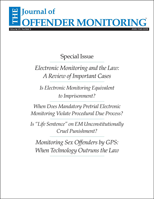Electronic Monitoring In the United States:The Transition and Expansion of Usage In Offender Populations
Author: Karla Dhungana Sainju.; Stephanie Fahy.; Katherine Baggaley (UOIT); Vanessa Filippelli (UOIT).; Ashley Baker (UOIT); Tamar Minassian (UOIT).
Source: Volume 29, Number 02, Fall/Winter 2016 , pp.7-19(13)

< previous article |next article > |return to table of contents
Abstract:
Since the first electronic monitoring tool was developed in the 1960s, both location monitoring and activity monitoring technologies have been applied to a variety of different populations within the criminal justice system, including but not limited to medium and high risk offenders, drug and alcohol related offenders,juvenile populations, domestic violence offenders, sex offenders, and gang members. This paper takes a retrospective look at the origin and evolution of electronic monitoring technologies in the United States and the various criminal justice populations that they have been applied to since their inception. The paper is divided into three sections based on the key phases within the criminal justice system: pre-trial, probation, and parole. While recognizing that specific offender populations are capable of falling under multiple phases, this paper focuses on a particular population within the phase where research has most predominantly been conducted.Keywords: General Pretrial Defendants; Domestic Violence Defendants; DUI and DWI Offenders; Juvenile Offenders; Sex Offenders; High-Risk Gang Offenders; Violent Offenders
Affiliations:
1: University of Ontario Institute of Technology; 2: Booz Allen Hamilton; 3: Univ Ontario Inst of Tech (UOIT); 4: Univ Ontario Inst of Tech (UOIT).